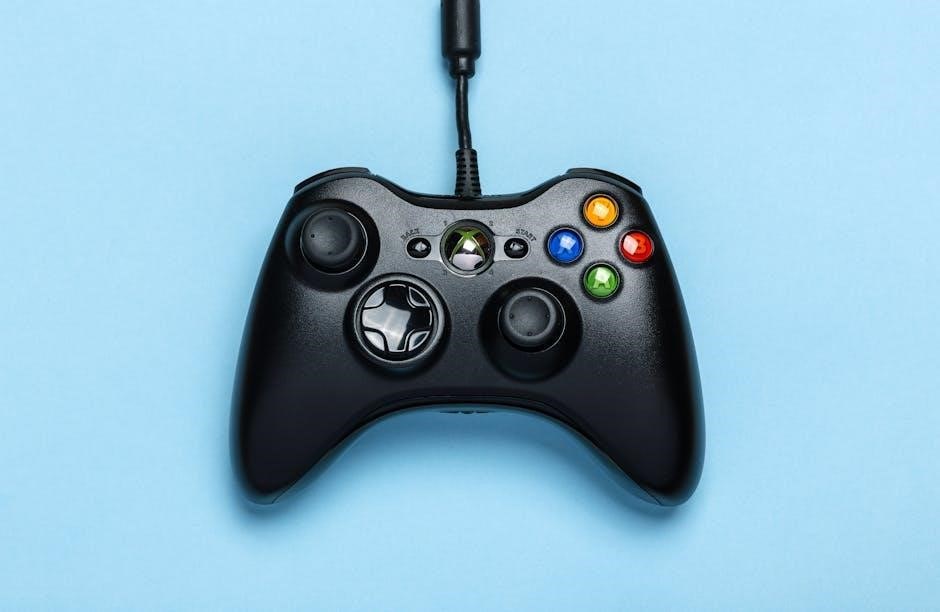The KickAss MPPT Solar Controller is a high-efficiency charge controller designed to maximize solar energy harvesting for off-grid systems‚ ensuring optimal battery charging and system performance.
Overview of the KickAss MPPT Solar Controller
The KickAss MPPT Solar Controller is a advanced charge controller designed to optimize energy transfer from solar panels to batteries‚ ensuring maximum efficiency and performance. It utilizes MPPT (Maximum Power Point Tracking) technology to harvest the highest possible energy from solar panels‚ reducing energy losses and improving overall system efficiency. Suitable for a wide range of applications‚ including off-grid solar systems‚ van conversions‚ and renewable energy setups‚ this controller is known for its durability and reliability. With an intuitive LCD display and user-friendly interface‚ it allows users to monitor and control their solar charging system easily. The KickAss MPPT Solar Controller is compatible with various battery types‚ including lead-acid and lithium batteries‚ making it a versatile solution for different energy storage needs. Its robust design and advanced features ensure reliable performance in diverse environmental conditions.
Importance of Using MPPT Technology
MPPT (Maximum Power Point Tracking) technology is crucial for optimizing solar energy systems‚ as it ensures maximum energy extraction from solar panels. Unlike traditional charge controllers‚ MPPT technology dynamically adjusts the system to operate at the optimal voltage and current‚ significantly reducing energy losses. This results in up to 30% more energy harvested compared to non-MPPT controllers. By maximizing efficiency‚ MPPT technology extends battery life and reduces the overall size of the solar array required. It also provides better performance in varying weather conditions‚ such as cloudy days‚ by continuously adapting to changes in solar panel output. For off-grid systems‚ this technology is essential for reliable and consistent energy generation‚ making it a cornerstone of modern solar power management.
Key Features of the KickAss MPPT Solar Controller
The KickAss MPPT Solar Controller stands out for its high-efficiency MPPT algorithm‚ which ensures maximum energy extraction from solar panels. It supports a wide range of battery types‚ including Lead-Acid‚ Lithium‚ and LiFePO4‚ with customizable charging profiles. The controller features multi-mode charging‚ including bulk‚ absorption‚ float‚ and equalization modes‚ to optimize battery health. With real-time monitoring capabilities‚ users can track system performance via an LCD display or remote communication interfaces. Its robust design includes overcharge‚ over-discharge‚ and short-circuit protection‚ ensuring safe and reliable operation. The controller also supports load control functions‚ enabling users to manage power distribution effectively. Its compact and durable construction makes it ideal for off-grid applications‚ from small solar systems to larger-scale installations‚ ensuring long-term performance and reliability.

Understanding the Components and Specifications
The KickAss MPPT Solar Controller includes advanced components like an MPPT charger‚ display screen‚ and communication ports. Its specifications highlight high efficiency‚ wide voltage range‚ and compatibility with various battery types.
What is an MPPT Solar Controller?
An MPPT (Maximum Power Point Tracking) solar controller is an advanced device that optimizes energy transfer from solar panels to batteries. It dynamically adjusts the voltage and current to match the battery’s needs‚ maximizing energy harvest. Unlike traditional PWM controllers‚ MPPT technology ensures minimal energy loss‚ making it highly efficient. This controller is essential for off-grid solar systems‚ as it stabilizes power flow and prevents overcharging or undercharging. By continuously monitoring and adapting to solar panel output‚ the MPPT controller ensures optimal performance in varying light conditions. Its ability to handle higher voltages and currents makes it ideal for larger solar setups. Essentially‚ it acts as a smart intermediary‚ ensuring your solar system operates at peak efficiency and prolongs battery life.
Benefits of Using an MPPT Controller
Using an MPPT controller offers numerous advantages‚ primarily enhancing the efficiency of your solar power system. It maximizes energy extraction from solar panels by continuously tracking and adjusting to the optimal power point‚ ensuring up to 30% more energy compared to traditional PWM controllers. This results in faster battery charging and extended system lifespan. MPPT controllers also provide better performance in varying weather conditions‚ such as cloud cover or temperature fluctuations. Additionally‚ they offer advanced protection features like overcharge prevention‚ short-circuit protection‚ and temperature compensation‚ safeguarding both the battery and solar panels. Their ability to handle higher voltages and currents makes them ideal for larger or scalable solar setups‚ offering flexibility and reliability for off-grid applications. Overall‚ an MPPT controller is a crucial investment for maximizing the potential of your solar energy system.
Technical Specifications of the KickAss MPPT Controller
The KickAss MPPT Controller is designed for high-performance solar energy management‚ featuring a robust set of technical specifications. It supports a maximum input voltage of up to 150VDC from solar panels and a maximum charge current of 60A‚ making it suitable for medium to large-scale solar systems. The controller operates at an impressive efficiency of up to 98%‚ ensuring minimal energy loss during power conversion. It is compatible with various battery types‚ including Lead-Acid‚ Lithium-Ion‚ and LiFePO4‚ with configurable charge voltage settings to match different battery chemistries; The controller also includes advanced protection features such as overcharge protection‚ short-circuit protection‚ and reverse polarity protection. Its durable design ensures reliable operation in harsh environments‚ with an operating temperature range of -20°C to +60°C. The controller also features an LCD display for real-time monitoring of system performance and customizable settings for optimized energy management.
Compatibility with Solar Panels and Batteries
The KickAss MPPT Solar Controller is designed to work seamlessly with a wide range of solar panels and battery systems‚ ensuring flexibility and adaptability for various off-grid setups. It supports solar panel inputs with a maximum voltage of up to 150VDC and is compatible with both 12V and 24V battery systems. The controller is optimized for use with Lithium-Ion‚ LiFePO4‚ and Lead-Acid batteries‚ offering customizable charge settings to suit different battery chemistries. Its compatibility extends to solar panels with varying power ratings‚ making it suitable for small to large-scale solar installations. Additionally‚ the controller supports both series and parallel configurations of solar panels‚ allowing users to maximize energy generation based on their system requirements. This versatility ensures the KickAss MPPT Controller can be integrated into diverse solar energy systems‚ providing reliable performance and efficient energy management.

Installation and Setup Instructions
Mount the controller securely‚ connect the battery‚ solar panels‚ and load‚ ensuring all connections are secure. Follow safety guidelines and refer to the manual for detailed setup instructions.
Pre-Installation Checklist
Before installing the KickAss MPPT Solar Controller‚ ensure all components are compatible with your system’s voltage and capacity. Verify the solar panel’s maximum power voltage (Vmp) and current (Imp) match the controller’s specifications. Check the battery type (e.g.‚ lead-acid‚ lithium) and its capacity to ensure proper charging. Inspect all cables and connections for damage or wear. Ensure the controller is rated for your system’s maximum power input. Review the installation manual for specific requirements. Disconnect all power sources before starting the installation to prevent electrical hazards. Prepare tools like screwdrivers‚ pliers‚ and wire strippers. Ensure the mounting location is secure‚ well-ventilated‚ and protected from extreme temperatures. Familiarize yourself with the controller’s display and settings to streamline the setup process.
Mounting the KickAss MPPT Controller
Mount the KickAss MPPT Controller in a well-ventilated‚ dry location to prevent overheating and moisture damage. Ensure the surface is flat and secure to avoid vibration. Use the provided mounting brackets or suitable fasteners to fix the controller firmly. Avoid areas exposed to direct sunlight or extreme temperatures. Keep it away from flammable materials. If installing in an enclosure‚ ensure proper airflow. Align the controller’s ports for easy access to connections. Double-check the mounting orientation to match the installation manual. Tighten all screws securely but avoid overtightening. Once mounted‚ verify the controller’s stability before proceeding with connections. Ensure all safety precautions are followed to prevent damage or electrical hazards.

Connecting the Battery to the Controller
Connect the battery to the KickAss MPPT Controller by attaching the positive terminal to the “BAT+” port and the negative terminal to the “BAT-” port. Ensure all connections are secure and free from corrosion. Use appropriate gauge wires to minimize voltage drop. Before connecting‚ verify the battery voltage matches the controller’s specifications. Turn off all loads and solar input to prevent surges. Double-check polarity to avoid damage or electrical hazards. Once connected‚ monitor the controller’s display for battery voltage and charging status. Ensure the battery is fully prepared and compatible with the controller’s charging parameters. Proper connection ensures safe and efficient energy management for your off-grid system.
Connecting Solar Panels to the Controller
To connect solar panels to the KickAss MPPT Controller‚ ensure the system is turned off. Connect the positive panel wire to the “SOLAR+” terminal and the negative wire to the “SOLAR-” terminal. Use appropriate gauge wires to minimize power loss. Verify the open-circuit voltage (Voc) and short-circuit current (Isc) of your solar panels match the controller’s specifications. Secure all connections firmly to avoid loose contacts. Cover the panels or disconnect them before making connections to prevent initial surges. Once connected‚ uncover the panels and monitor the controller’s display for solar input voltage and current. Ensure the system is functioning correctly by checking the charging indicators and adjusting settings as needed. Proper connections ensure efficient energy transfer from solar panels to the battery. Always follow safety precautions to avoid electrical hazards.
Connecting the Load to the Controller
To connect a load to the KickAss MPPT Controller‚ first ensure the battery is fully connected and the system is operational. Identify the “LOAD+” and “LOAD-” terminals on the controller. Connect the positive wire of your load (e.g.‚ lights or appliances) to the “LOAD+” terminal and the negative wire to the “LOAD-” terminal. Ensure the wires are appropriately sized for the load’s current draw to prevent overheating; Double-check the polarity to avoid damage or short circuits. Once connected‚ test the load by turning it on and verifying it operates correctly. Monitor the controller’s display for load current and voltage to ensure the system is functioning within safe limits. Always prioritize safety and use circuit protection devices if required. Proper load connections ensure reliable power distribution from the solar system to your appliances. Follow the manufacturer’s guidelines for load capacity to avoid overloading the controller.

Configuration and Settings
Configure the KickAss MPPT Controller by navigating its intuitive interface to set charge parameters‚ battery thresholds‚ and load control. Enable monitoring for real-time system performance tracking.
Understanding the Controller’s Display and Indicators
The KickAss MPPT Controller features an LCD display showing real-time data such as battery voltage‚ charge current‚ and solar input. LED indicators provide status updates: green for normal operation‚ red for faults. The display also shows error codes‚ helping users identify issues quickly. Use the navigation buttons to scroll through menus and view detailed information like charge mode‚ temperature‚ and system alerts. Familiarizing yourself with these indicators ensures efficient monitoring and troubleshooting‚ allowing you to optimize your solar setup for peak performance. Regularly check the display to maintain your system’s health and address any alerts promptly.

Setting Up Basic Parameters
Setting up basic parameters on the KickAss MPPT Controller is essential for ensuring optimal performance. Start by configuring the battery type‚ selecting from options like Lead-Acid‚ AGM‚ or Lithium. Next‚ set the battery capacity in Ah to match your system. Input the maximum charge current and voltage limits to protect your battery. Define the load control settings‚ such as the minimum battery voltage for load disconnection. Adjust the time settings for backlight and auto-shutoff to conserve energy. Ensure all parameters align with your specific setup to prevent overcharging or undercharging. Use the navigation buttons to scroll through the menu and confirm each setting. Proper configuration guarantees efficient energy management and system safety‚ ensuring your solar setup operates smoothly and reliably.
Configuring Charge Settings
Configuring charge settings on the KickAss MPPT Controller ensures your battery receives the correct charging profile. Access the charge settings menu and select the battery type‚ such as Lead-Acid‚ AGM‚ or Lithium‚ to match your system. Set the maximum charge voltage and current to prevent overcharging. Choose the charge mode‚ such as Bulk‚ Absorption‚ or Float‚ based on your energy needs. Enable features like equalization charging for maintenance‚ if required. Adjust the charging algorithm to optimize for your battery’s specifications. Save the settings to apply the configuration. These parameters ensure the controller charges your battery safely and efficiently‚ prolonging its lifespan. Properly configured charge settings are crucial for maximizing your solar system’s performance and reliability. Always refer to the user manual for specific guidelines tailored to your setup.
Setting Up Load Control Functions
Setting up load control functions on the KickAss MPPT Controller allows you to manage how and when power is supplied to your appliances. Access the load control menu to enable or disable load output based on battery voltage or solar input. Set the low voltage disconnect (LVD) threshold to prevent battery depletion. Configure the timer function to automatically turn loads on or off at specific times. Adjust the load priority settings to ensure critical appliances receive power first. Enable the backlit display to monitor load status. Test the load control functions by simulating different scenarios to ensure proper operation. Fine-tune the settings as needed to match your energy usage patterns. Properly configured load control functions help optimize energy distribution‚ extend battery life‚ and ensure reliable system performance. Always refer to the user manual for detailed instructions tailored to your setup.

Enabling Communication and Monitoring
To enable communication and monitoring for the KickAss MPPT Controller‚ start by connecting it to your monitoring system or smartphone app. Use the provided USB or Bluetooth adapter to establish a connection. Download and install the official KickAss monitoring software or app to access real-time data. Open the app and follow the pairing instructions to link the controller with your device. Once connected‚ you can monitor key metrics such as solar input‚ battery voltage‚ charge current‚ and system temperature. Set up alerts for low battery levels‚ overcharging‚ or high temperatures. Customize the monitoring interface to display the data most relevant to your needs. Regularly check the controller’s firmware version and update it if necessary to ensure optimal performance. Use the historical data to analyze system performance and make adjustments for better energy efficiency.

Troubleshooting Common Issues
Identify common issues like error codes‚ low battery alerts‚ or solar charging faults. Check connections‚ reset the controller if necessary‚ and ensure firmware is updated for optimal performance.
Identifying Common Problems with the Controller
Common issues with the KickAss MPPT Solar Controller include error codes‚ low battery alerts‚ and solar charging faults. Users may encounter problems such as the controller unexpectedly stopping charge‚ incorrect battery voltage readings‚ or communication issues with connected devices. Some users have reported challenges with the controller’s display not showing accurate data‚ while others face difficulties in resetting the device to factory settings. Additionally‚ connectivity problems between the controller and solar panels or batteries can arise‚ often due to loose connections or improper setup. It’s important to systematically troubleshoot by checking all connections‚ ensuring firmware is updated‚ and referring to the user manual for guidance on resolving these issues effectively.
Understanding Error Codes and Alarms
The KickAss MPPT Solar Controller displays specific error codes and alarms to indicate issues. Common error codes include “E01” for battery overvoltage‚ “E02” for under-voltage‚ and “E03” for over-temperature conditions. These codes help users quickly identify and address problems. Alarms may sound or flash on the display when the system detects faults such as short circuits‚ open circuits‚ or communication failures. Understanding these codes is crucial for troubleshooting effectively. Users should refer to the user manual for a comprehensive list of error codes and their meanings. By recognizing and resolving these alerts‚ users can ensure the controller operates efficiently and prolong the system’s lifespan. Regular checks and updates can help prevent recurring issues and maintain optimal performance.
Troubleshooting Solar Charging Issues
When solar charging issues arise‚ start by checking the solar panel connections to ensure they are secure and not damaged. Verify that the panels are clean and free from shade‚ as obstructions can significantly reduce efficiency. If the controller’s display shows no input from the panels‚ inspect the wiring for loose connections or faults. Ensure the MPPT settings are correctly configured for your panel’s voltage and current ratings. If issues persist‚ check the error codes on the controller‚ such as “E01” or “E03‚” which may indicate overvoltage or temperature-related problems. Resetting the controller or updating its firmware can sometimes resolve software-related glitches. Always refer to the user manual for specific troubleshooting steps tailored to the KickAss MPPT Solar Controller. Regular system checks can help prevent charging issues and ensure reliable energy generation.
Resolving Battery Charging Problems
When encountering battery charging issues with the KickAss MPPT Solar Controller‚ begin by checking the battery terminals for tightness and corrosion. Ensure the battery is properly connected to the controller‚ with correct polarity. If the controller indicates a “low battery” status‚ verify that the solar panels are generating sufficient power. Check for error codes such as “E04” or “E05‚” which may signal battery temperature or communication issues. Adjust the charge settings to match your battery type‚ whether it’s lead-acid‚ AGM‚ or lithium. If the problem persists‚ ensure the controller’s firmware is up-to-date‚ as outdated software can cause charging inefficiencies. Resetting the controller to factory settings may also resolve unexpected behavior. Always consult the user manual for specific guidance on diagnosing and resolving battery-related issues effectively. Regular maintenance and proper configuration are key to ensuring reliable battery performance.
Resetting the Controller to Factory Settings
To reset the KickAss MPPT Solar Controller to factory settings‚ first ensure the battery is connected and charged. Disconnect all loads from the controller to prevent any power draw during the reset process. Locate the small reset button on the controller‚ typically found on the rear or side panel. Using a pin or small tool‚ press and hold the reset button for approximately 10 seconds until the LED indicators flash rapidly. Release the button and wait for the controller to reboot. Once the LEDs stabilize‚ the controller will revert to its default settings. Note that resetting will erase all custom configurations‚ so you will need to reconfigure charge settings‚ load control‚ and monitoring options. Consult the user manual for detailed instructions specific to your controller model. This step is ideal for resolving persistent issues or starting fresh with a clean configuration. Always ensure the battery is connected before performing a reset to avoid further complications.

Maintenance and Optimization Tips
Regularly clean the solar panels and inspect the controller for dust or corrosion. Ensure all connections are secure to maintain optimal performance and longevity of the system.
Regular Maintenance Tasks
Perform routine inspections of the KickAss MPPT controller and solar panels to ensure optimal performance. Check for dust‚ dirt‚ or corrosion on surfaces and connections. Clean solar panels regularly to maintain efficiency‚ as dirt can reduce energy absorption. Inspect battery terminals and cables for tightness and signs of wear. Ensure all electrical connections are secure to prevent power loss or damage. Monitor the controller’s display for error codes or alarms‚ addressing issues promptly. Schedule periodic firmware updates to benefit from the latest features and improvements. Keep the controller in a cool‚ dry environment to prevent overheating and extend its lifespan. Regular maintenance ensures reliable operation and maximizes the system’s energy output.
Cleaning and Inspecting the Controller
Regularly clean and inspect the KickAss MPPT controller to ensure optimal performance and longevity. Use a soft‚ dry cloth to wipe down the controller’s surfaces‚ avoiding liquids that could damage electrical components.
Inspect all terminals and connections for tightness‚ corrosion‚ or wear. Clean any corrosion using a gentle abrasive or corrosion remover‚ and ensure all cables are securely attached.
Check for dust or debris accumulation on the controller’s heat sink or vents‚ as this can impede cooling and efficiency. Use compressed air to gently remove dust without touching internal components.
Look for signs of physical damage‚ such as cracks or dents‚ and address them promptly to prevent further issues. Regular cleaning and inspection help maintain efficiency and prevent potential failures.
Updating Firmware and Software

If the battery isn’t charging properly‚ start by checking the connections between the controller‚ battery‚ and solar panels. Ensure all terminals are clean‚ secure‚ and free from corrosion.
Verify that the battery is fully recognized by the controller in the display settings. If the battery type or capacity is incorrect‚ adjust the settings accordingly.
Monitor the charge status and voltage levels to identify if the issue lies in the charging phase or battery absorption.
Check for any error codes or alarms on the controller‚ which can indicate specific problems such as overvoltage‚ undervoltage‚ or communication issues.
If the problem persists‚ perform a factory reset on the controller and reconfigure the settings. Additionally‚ test the battery independently to ensure it is functioning correctly and holding charge.
Optimizing Solar Panel Performance
Optimizing solar panel performance with the KickAss MPPT Solar Controller involves ensuring your system operates at peak efficiency. Regularly clean and inspect solar panels to remove dirt or debris that may reduce energy absorption.
Position panels to receive maximum sunlight‚ avoiding shading from nearby objects. Adjust the panel angle based on seasonal changes to maximize energy capture.
Use the controller’s monitoring features to track real-time performance and identify potential issues. Ensure charge settings are configured correctly for your battery type and capacity.
Periodically update the controller’s firmware to access new features and performance improvements. By maintaining proper alignment‚ cleanliness‚ and settings‚ you can ensure your solar system delivers optimal energy output consistently. This helps extend the lifespan of both the panels and the battery‚ maximizing your off-grid power reliability.